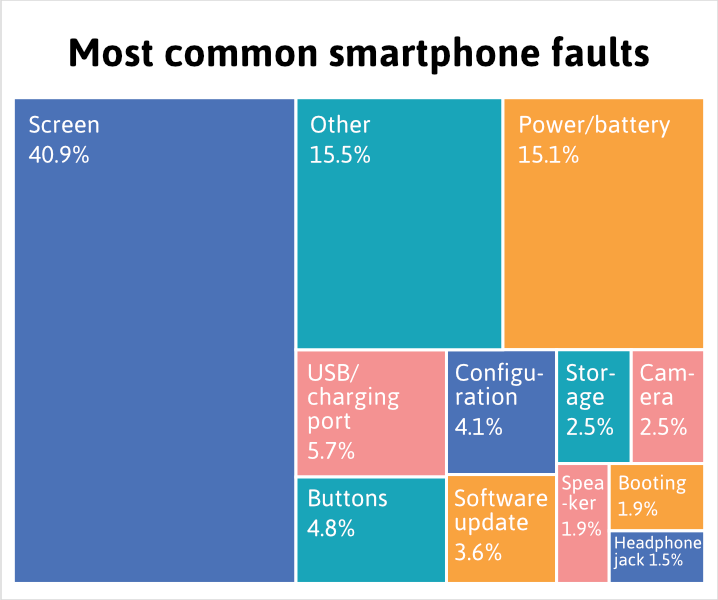Why do smartphones fail? What are the barriers to smartphone repair?
Data from the Open Repair Alliance, based on the analysis of over 1900 repairs of smartphones at community repair events, shows that just about half of repairs are successful today, which provides a strong rationale for extending the availability of spare parts and repair information to end-users.
Repairs conducted at community repair events involve multiple fault types, among which 41% were linked to screens, 15% to battery and other power-related issues; 6% were linked to charging ports, 2% with on/off buttons, 3% with other buttons; 3% with cameras, 2% with speakers or amplifiers, and another 1% with microphones.
Based on the above, we believe that the range of spare parts available to both consumers and community repair initiatives should be extended as the lack of access to quality parts would mean that community initiatives and consumers would not be able to use high-quality parts from manufacturers for over 40% of the repairs they attempt.
Data from community initiatives provided by Open Repair Alliance is also revealing of end-users’ determination to keep using devices for longer: 22% of the devices brought to these events are 5 to 10 years old, thus making clear the need for long-lasting software support.
Where does the data come from?
Open Repair Alliance partner The Restart Project facilitated two online microtasking quests where volunteer participants looked at Open Repair Alliance data on about 1900 mobile phone repair attempts recorded at community events. The aim of these quests was to sort the records into buckets of fault “types”.

MobiFix was held in July 2020 using data from The Restart Project. MobiFix:ORA was held in March 2021 using data from anstiftung and Repair Café International.
Community repair events are busy with volunteers concentrating their efforts on the people and the devices that turn up. The data that gets recorded by a fixer is their description of the situation at the time. Microtask participants would read this “problem” text and judge whether it fitted any of the “fault types” that were presented. Based on consensus of these opinions, the fault type for the devices were assigned.
Download the MobiFix data
You can download the resulting data on mobiles and fault types here: https://github.com/openrepair/data/tree/master/quests/mobiles
Note: There are some differences in the structure of this data and any of the ORDS format versions (0.1 and 0.2). The records involved span different ORDS versions and a handful have not yet been exported.
- The usual ORDS
idvalues have been replaced by special mobifix-specific unique identifiers - The
modelfield was removed from the ORDS v0.2 standard but was useful for these quests and so has been retained in this dataset - Age is an important metric in repair policy, therefore it was derived from and replaced the
year_of_manufacturefield - The field
group_identifieris irrelevant in this analysis and thus has been omitted from the dataset
